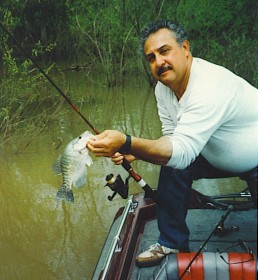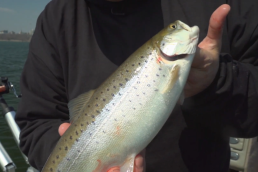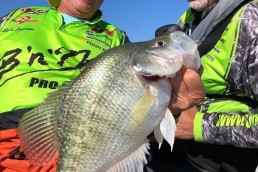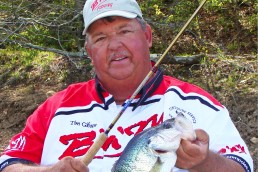Illinois Spring Crappie Outlook
SHARE THIS POST
From one end of the state to the other, Illinois anglers are gearing up for another season on the water. And, just as wing shooters look forward to opening day of mourning dove season, most fishermen eagerly anticipate spring crappie fishing.
Just as doves are not the largest or most spectacular of gamebirds, crappies are usually lumped together with bluegills, sunfish and pumpkinseeds under the heading of “panfish.” While this generic moniker is descriptive of the fish’s overall shape, it could more appropriately apply to the crappie’s delicious relationship with the frying pan.
In Illinois, crappies don’t grow very big, normally attaining a length of 9 to 12 inches. That is not to say there aren’t 14- to 18-inch fish happily swimming around out there, but if you do get one of them, you can consider it a braggin’-sized fish.
Once the ice goes off the lakes in late February, most crappie fishermen take some time off to prepare for the upcoming spring spawning season, when the best, easiest and fastest crappie fishing occurs. For that reason, let’s look at when the spawning urge strikes these fish, and how they respond to it.
First, don’t worry about global warming, climate change, warm/cold winters or any other weather-related events. DNR biologists tell us none of these have anything to do with when the crappies move into the shallows with a glint in their eyes.
A crappie’s biological trigger is tripped exclusively by the lengthening of daylight hours, technically termed the photoperiod. In North America, crappies will not commence their spawning effort until mid-April, when the length of the day stretches out. Since the photoperiod is basically the same throughout all of Illinois, crappies from north to south will respond to it at the same time. Once the photoperiod reaches the proper length, the fish are ready to do their thing—but then two other factors enter the equation.
Water temperatures must rise to the mid-50s. This is the reason the crappies begin spawning earlier in southern climes than they do in the north. But bear in mind that none of them will begin spawning before they sense the proper amount of daylight.
The third factor influencing crappie spawning is water clarity. The fish shun cloudy, muddy water. To test for proper clarity, you can use what the biologists call a Secchi disc. This is nothing more than a one-foot-diameter white plate, tied on a line. Lower the disc into the water, flat side up, and if you can still see it one foot beneath the surface, you are in business.
The crappies will continue their spawning effort until they get the job done. They will move on and off the nests, after the proper photoperiod arrives, motivated by fluctuations in water temperature and water clarity. Given steady, warm weather, the spawn may be over by mid-May. But during a spring when constant cold fronts disturb the nesting effort, the fish could still be on the beds until mid-June.
Crappies can be found in lakes and rivers all over the state, and by consulting the DNR web site (dnr.state.il.us, and clicking on the I Fish Illinois link), you can locate the fishing area nearest you.
The Fox Chain O’Lakes is located approximately fifty miles northwest of Chicago on Illinois Routes 173 and 12, near the towns of Antioch and Fox Lake. Its 6,500 acres of water make the Chain the largest inland water-related asset in northeast Illinois. The Chain is classified as a public navigable waterway and managed under the authority of the IDNR and the Fox Waterway Agency, which requires an annual user fee for watercraft. (Contact Fox Waterway Management Agency, 1-847-587-8540 for details.)
Are you enjoying this post?
You can be among the first to get the latest info on where to go, what to use and how to use it!
In 1978, the Illinois Power Company completed construction of Clinton Lake in DeWitt County in central Illinois. The lake provides cooling water for the Clinton Power Station. That same year, the DNR signed a long-term lease with the power company to manage and maintain the 10,000-acre public recreation area, which includes the 5,000-acre lake. The lake can easily be accessed from Interstate Routes I-55, I-57, I-72 and I-74, and U.S. 51 via IL Routes 10, 54, and 48.
Located near Shelbyville in central Illinois, 11,100-acre Lake Shelbyville features an irregular, Y-shaped shoreline with numerous deep bays and coves. The distance from the dam to the headwaters is 20 miles. A Lake Shelbyville Guide booklet is available from the usual DNR source and is especially recommended for first-time fishermen.
This lake offers a long list of services and recreational opportunities. Free boat launching sites are conveniently located all around Lake Shelbyville.
The lake has good populations of both white and black crappies, but being a very big lake, a guided trip or two would put you on the fish much quicker than doing it yourself. Mary Satterfield is a former Lady Bass Classic World Champion, and she has been guiding on Lake Shelbyville for, ah, well, quite a while. Mary can show you how to pull the crappies from this big lake. Check out her services on-line.
If you don’t mind doing some exploring, head for the Mighty Mississippi Rivern where you can expect to catch a basket full of 1- to 2-pound crappies. However, a lot of water, backwaters and old lakes make up Ole Man River, and you will have to do a little work to find the proverbial jackpot. But make no mistake about it, the jackpot is there, and it is filled with treasure—crappies!
To help you get started fishing the Father of Waters, I once again refer you to IDNR booklets—this time a pair of them—that concentrate on Fishing the Upper or Middle Mississippi River. You can get them at the usual places or request them on-line.
Perhaps Illinois’ highest-rated crappie hot spot is sprawling Rend Lake in Jefferson County. The nearest town to Rend Lake is Benton, which is not exactly a household word, so I’ll try to pinpoint it for you. Rend Lake straddles I-57 about halfway between Mount Vernon and Marion, in southern Illinois.
While Rend Lake has a huge crappie population, unless you know how, when and where they are to be caught, you are going to be spinning your wheels in a land of plenty. Once again, I direct you the IDNR’s very helpful fishing booklet, and suggest that you hire a guide to show you the ropes. There is an abundance of Rend Lake fishing guides, and the internet can put you in touch with most of them.
The days are getting longer, and the crappies are on their way. Make your plans now.
MWO
SHARE THIS POST
Did you enjoy this post?
You can be among the first to get the latest info on where to go, what to use and how to use it!
Jerry Pabst
Jerry Pabst has been writing about the outdoors for over 40 years. He captained a Lake Michigan charter boat for 25 years and was inducted into the Fresh Water Fishing Hall of Fame. He has hunted waterfowl in all North American flyways, pursued upland game extensively, and trains his own dogs.



